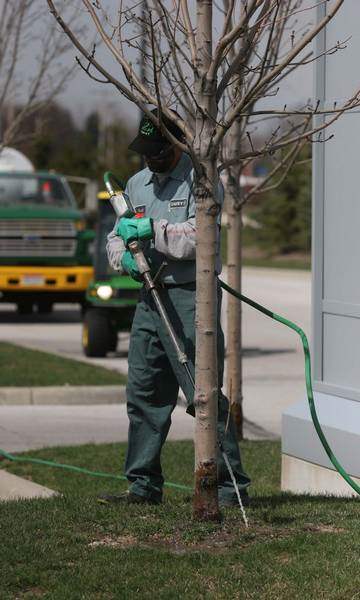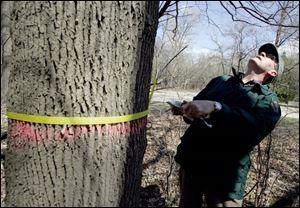
Ash borer's spread is costly for landowners
4/13/2006
Chuck Karbowiak treats an ash tree in Oregon with insecticide.

Chuck Karbowiak treats an ash tree in Oregon with insecticide.
Property owners in northwest Ohio and southeast Michigan have a choice to make now that government efforts to control the spread of the emerald ash borer locally have failed.
Cut down that favorite, majestic ash tree that has provided back-yard shade for decades, or fight back against the deadly green bug with an insecticide that has shown promise.
Even some experts disagree over which way to go, but they all agree that regardless of the decision, property owners will be hit hard in their pocketbooks - possibly to the tune of thousands of dollars a tree. That possibility has become even more of a reality in northwest Ohio now that the state Department of Agriculture has abandoned containment cutting efforts in the region due to a lack of federal funds.
Yet waiting and doing nothing could prove even more costly.

Ash trees become brittle faster than other trees and "have a tendency to fall down more so than other trees," said Dan Herms, an entomologist for the Ohio State University's extension service and the state's lone representative on an international board established to fight the pest.
Amy Stone, an OSU extension agent in Toledo, said that perhaps the first thing most people need to do is check their homeowners' policies and consult with their insurance agents. Some insurance companies now will not cover losses caused by dead ash trees that weren't taken down, she said.
The presence of ash trees has raised the possibility of even more far-reaching implications for property owners, including problems obtaining or renewing homeowners' insurance, preventing the closing on the sale of a property, or even becoming a foreclosure issue with mortgage holders.
So if waiting is not an option, should a property owner cut or spray?

John Jaeger, director of natural resources for the Toledo Area Metroparks, measures an ash tree for removal in Pearson Metropark in Oregon, site of an emerald ash borer infestation.
That's where sentimentality enters the process, experts say. Some people are willing to absorb annual treatment costs and give the insecticides a try to save a backyard ash tree that might have been planted by family members when they were young.
Sometimes the condition of the tree makes the decision easier, though perhaps not emotionally or financially. If you've had woodpeckers attack your ash tree, don't get your hopes up. Woodpeckers are drawn to borers crawling beneath the tree bark.
Removing a tree costs an average $1,200, and size, location, and the tree's condition are key factors, said Scott Kirby, an arborist and district manager of the Davey Tree Expert Co., an employee-owned company that operates in 38 states and Canada.
A would-be customer in the Old West End got a much bigger case of sticker shock. In what he emphasized was a highly unusual situation, Mr. Kirby said he wrote up a $25,000 bid for removing one massive tree because it was in tight proximity between homes and had to be cut down by hand.
The health of the tree can be a problem because dead trees are hard, if not impossible, for tree-cutters to climb and cost more to remove, he said.
Treating ash trees with the most proven insecticide - products with an active ingredient called imidacloprid - has shown promise, at least on a short-term basis. But each treatment costs about $250, depending on the size of the tree and the amount of insecticide that has to be used. And the treatments must be done every year.
Homeowners who put all their faith in chemicals that may or may not work are taking a gamble not unlike that of people who wait to act, experts say.
"Whether people are being foolhardy or not [with chemical applications] is how people feel about a particular tree," said Elliot Tramer, the University of Toledo's first ecology professor. "The problem, of course, is that nobody really knows what the true probability of success is."
The question of long-term success is one hotly debated between arborists, who stand to make money from applying the chemicals, and researchers, who are reluctant to call anything a cure without years of data and ironclad proof.
"I knew from Day 1 this was going to work," said an eager-to-treat arborist named Wayne White, who owns a company called Emerald Tree Care in White Lake, Mich. He fumes about how government officials have led people to believe the chemical applications do not work.
Formed just after the borer was identified in a western Detroit suburb in 2002, his company specializes in treating both healthy and infested ash trees. He swears by his product.
Mr. Herms, the OSU extension entomologist who is also a former pest manager for Dow Gardens in Midland, Mich., is not so sure about chemicals. He works in conjunction with Michigan State University entomologists, who are encouraged by preliminary results of products with imidacloprid, but are not ready to declare them a cure. "In trees treated in consecutive years, the infestation has been slowed down but not stopped," he said. "We don't know if the insecticide will provide long-term answers or just put off the problem."
Mr. Herms said he is using chemicals to take a shot at saving one beloved ash tree on property he and his wife own in Michigan's Midland County. "We're willing to take the chance that the insecticides will work," he said.
Mr. Kirby said he encourages people to consider products with imidacloprid but added that he thinks it will only work at keeping the borer from healthy trees. Mr. White and Mr. Herms agreed that the healthier the tree, the better its odds of surviving with chemical treatments.
In Oregon, Bay Park Community Hospital has 110 healthy ash trees being treated with products that contain imidacloprid. All, now about a decade old, were planted in 2001 as the hospital grounds were being landscaped.
Mike Swartz, an employee in the hospital grounds crew, said products with imidacloprid were applied right after the beetle was identified in southeastern Michigan in 2002, as well as 2003 and 2004. The application was skipped last year was because the hospital feared the trees would end up being cut down by state contractors cutting other trees in Oregon, including some infested trees found just off the hospital grounds.
Treatment resumed this year, Mr. Swartz said, with no sign of the beetles on the hospital grounds yet. "We were in the center of it. We seemed to weather it well," he said.
White ash and green ash were the darling of landscapers because of their versatility to soil types and climatic conditions, plus the wonderful shade they produced. They were seen by many as the replacement for the American elm, which was crippled and nearly eliminated by Dutch elm disease that swept across the country midway through last century.
On a recent hike through Pearson Metropark in Oregon, John Jaeger pointed out a single elm. But that's the problem: They exist in such sparse numbers compared to what they used to be that there's almost a museum-like quality to them.
Such will likely be the eventual fate of ash trees, said Mr. Jaeger, natural resources director for Toledo Area Metroparks.
The park district estimates that it has more than 100,000 ash trees left. Both Mr. Jaeger and Scott Carpenter, Metroparks spokesman, said it would be physically and financially impossible to treat them all every year. Metroparks may dedicate some ash trees for experiments to test the effectiveness of imidacloprid, but only on a limited basis, Mr. Jaeger said.
Even Mr. White said there is no way a business like his could save a forest. He said he is only out to give homeowners a shot at saving a few trees on their property that are close to their heart.
"We're really talking about trees on individual lots," he said.
Several area residents fumed last year when Pearson Metropark was closed for six weeks so state agriculture crews could take down 20,000 trees they had marked. As it turned out, only half were removed before funding got used up.
Those among the 10,000 left standing that are far enough away from picnic shelters and other high public-use areas will be left to die naturally and serve as wildlife habitat. Some will be removed in the coming weeks.
Mr. Jaeger is part of a Metroparks task force on the ash borer that recently issued a page-full of recommendations. Among them: No parks are to be closed for extended periods because of ash tree removal.
The task force said it wants the park district to "accept that trees are going to die - and make it clear to the public and staff that all responses and actions are based on this premise."
Contact Tom Henry at:
thenry@theblade.com
or 419-724-6079.